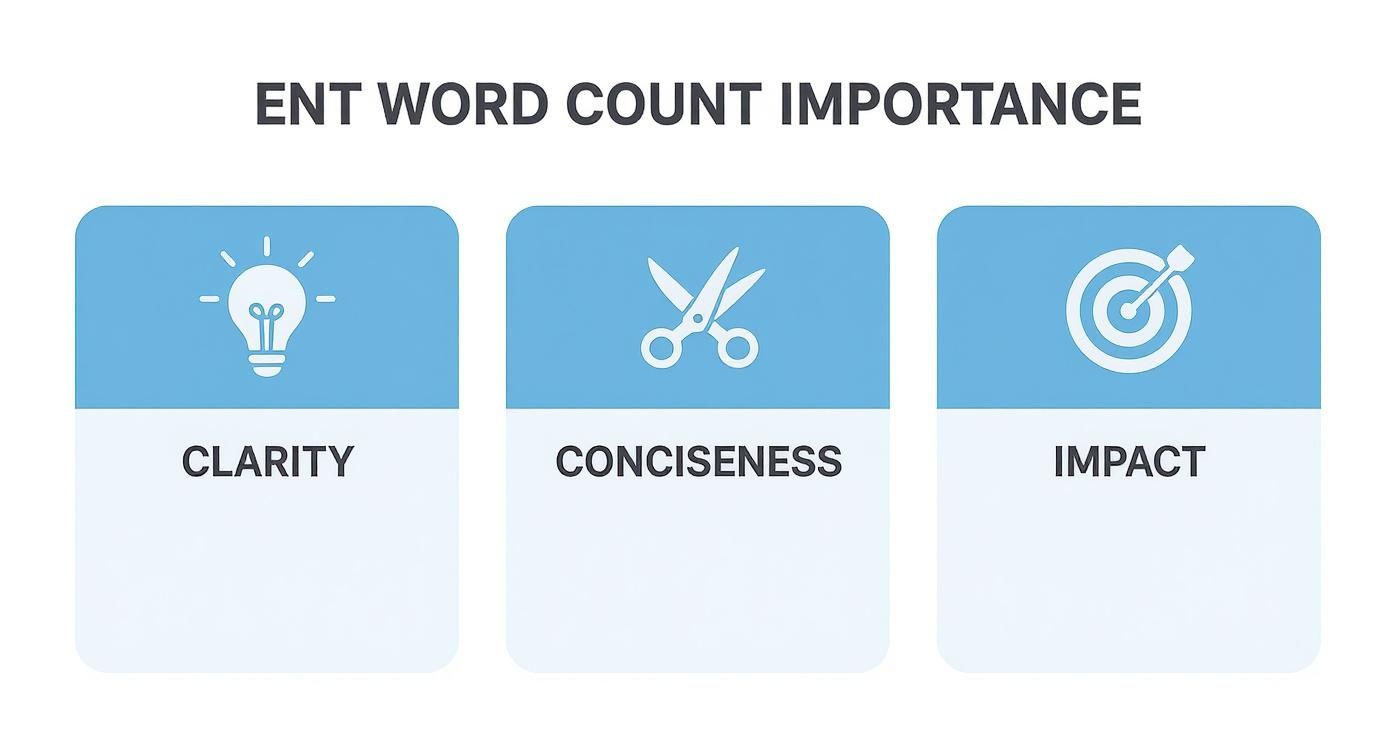When you first see the word count limit on a personal statement, it can feel like a major roadblock. For undergrad applications like the Common App, you're looking at a cap of around 500 to 650 words. For medical school, they often switch to character counts, typically around 5,300 characters.
This isn't just a friendly suggestion—it’s a hard-and-fast rule that dictates how you frame your entire story.
Why Your Personal Statement Word Count Matters
That strict word or character limit might seem like your biggest enemy, but what if you treated it as your first chance to make a great impression? The limit isn't an arbitrary hoop to jump through; it’s a built-in test of your ability to be clear, concise, and compelling.
Think of it as your elevator pitch to the admissions committee. Every single word has to earn its spot.
This constraint pushes you to boil down your experiences, your goals, and your personality into a tight, focused narrative. On a practical level, it proves you can follow instructions—a non-negotiable skill in any academic or professional field. More importantly, it shows you can communicate effectively, which is a massive green flag for admissions officers.
A Test of Clarity and Focus
Admissions committees are buried under thousands of essays. An applicant who can land a powerful punch in 600 words is way more impressive than someone who rambles on for 1,000.
Respecting the word count shows you respect their time. It also proves you have the critical thinking skills to cut through the noise and highlight what truly matters. This kind of focus is a huge part of understanding what medical schools look for in an applicant, as they’re always on the lookout for candidates who can process and present complex information efficiently.
The word limit is there to challenge you. It's a filter that separates applicants who can self-edit and prioritize from those who can't.
Key Application System Differences
The expectations for your essay can shift dramatically from one application system to another, which makes sticking to the word count even more critical.
Here’s a quick breakdown:
- The Common App (US): Gives you up to 650 words. This allows for a more narrative, storytelling style where you can really develop a personal theme.
- UCAS (UK): Slaps you with a strict 4,000-character limit (spaces included), which encourages a much more direct, academically focused tone.
Getting these nuances right is the first step. To really see how to make an impact within these tight spaces, it’s a great idea to spend some time reviewing winning scholarship essays, which almost always have to pack a big punch into a small package.
Decoding Common Application Word and Character Limits
Once you move from general advice to specific applications, the numbers game gets brutally real. Every platform, especially in the medical field, has its own strict set of rules. Understanding these isn't just about checking a box; it’s about knowing the exact size of the canvas you have to tell your story.
Most of these systems don't use a word count. Instead, they run on a character count, which includes every single letter, space, and punctuation mark. This gives them a precise, standardized measure that leaves zero room for debate. Forgetting this tiny detail is a classic pitfall that can force you into painful, last-minute edits right before the deadline.
This infographic breaks down why mastering these limits is so critical for your application's success.

The bottom line is simple: respecting the personal statement limits forces you to sharpen your message until it’s clear, concise, and impossible to ignore.
Medical and Residency Application Limits
For anyone dreaming of a white coat, the character limits are non-negotiable. Major platforms like AMCAS, AACOMAS, and TMDSAS are the gatekeepers to medical school, and each one has a precise character limit you absolutely must meet. They don’t give you a word count target, only the character maximum, which is why you need to get comfortable with the conversion.
A good rule of thumb is that one word equals roughly six characters (counting a space). Using this math, a 5,300-character limit works out to be about 880 words. That’s the ballpark figure you should aim for when you start outlining your narrative.
Let's break down the specifics for the big three:
- AMCAS (American Medical College Application Service): The personal comments essay is capped at a firm 5,300 characters.
- AACOMAS (American Association of Colleges of Osteopathic Medicine Application Service): The personal statement here also has a 5,300-character limit.
- TMDSAS (Texas Medical and Dental Schools Application Service): This application gives you a little less room to work with, setting a hard limit of 5,000 characters.
A word of caution: these systems offer zero wiggle room. If you go over the character count by even one, you'll get an error message and won't be able to submit. Period.
The Special Case of ERAS
The Electronic Residency Application Service (ERAS) is a whole different beast. It’s the platform for residency applications, and it gives you a much more generous space for your personal statement—a sprawling 28,000 characters.
While this sounds like a luxury, it brings its own set of challenges. You have more room to tell your story, but the risk of rambling, losing focus, or boring the reader increases dramatically. Every sentence still needs to be intentional. For a deep dive, you can learn more about the ideal ERAS personal statement length and how to use all that space effectively.
To give you a clear, at-a-glance reference, I’ve put together a table comparing these key application systems.
Personal Statement Limits Across Major Application Systems
This table offers a quick comparison of the character limits and their approximate word count equivalents for the main medical and residency application platforms.
| Application System | Character Limit (with spaces) | Approximate Word Count | Primary Field |
|---|---|---|---|
| AMCAS | 5,300 | ~880 words | MD Programs (US) |
| AACOMAS | 5,300 | ~880 words | DO Programs (US) |
| TMDSAS | 5,000 | ~830 words | Texas Med/Dental |
| ERAS | 28,000 | ~4,500 words | Residency (US) |
Keep this guide handy as you draft your statements. Knowing your exact limits from the start will save you a world of headaches later on.
Navigating UK and US Application Differences

Applying to universities in both the UK and the US is a bold move, but it means writing two completely different personal statements. This isn't just a matter of changing a few words; the expectations for tone, structure, and content are worlds apart. One of the biggest mistakes international applicants make is treating them as interchangeable. They're not.
The US application, typically done through the Common Application, gives you a generous 650-word limit. This isn't just extra space—it’s a signal. US admissions committees are looking for a story. They want to see your personality shine through, understand how you've grown, and hear a compelling narrative that reveals your character.
The UK's UCAS system, on the other hand, is a different beast entirely. It's far more restrictive and laser-focused on academics.
The UK UCAS System Explained
The UCAS personal statement works with a strict 4,000-character limit. That includes every letter, space, and punctuation mark. This usually works out to somewhere between 500 and 600 words, forcing you to be incredibly direct and concise. There is absolutely zero room for fluff.
This tight limit reinforces what the UK university system cares about most: your academic suitability for a specific course. They want to know why you're passionate about your chosen subject, what you've done to explore it, and how you’re prepared for rigorous, university-level study.
The core difference is simple: The US asks, "Who are you as a person?" while the UK asks, "Why are you the right student for this specific course?" Your personal statement must answer the right question for the right audience.
Traditionally, successful UK applicants dedicate around 80% of their statement to their academic interests and strengths, leaving just a sliver of space for extracurriculars. This intense focus is a well-documented feature of the application. You can dig into more data-driven insights about UK personal statement trends on jstor.org.
A Shift to Structured Questions
The landscape for UK applications is also evolving. Starting in the near future, UCAS will be moving away from the single essay format and toward a series of structured questions. While the overall 4,000-character limit may remain, it will be divided among specific prompts, demanding even greater precision and focus from applicants.
Let's break down the critical differences side-by-side.
| Feature | US Common App | UK UCAS |
|---|---|---|
| Limit | 650 words | 4,000 characters (~500-600 words) |
| Primary Focus | Holistic Storytelling (who you are) | Academic Suitability (why this course) |
| Tone | Narrative, reflective, personal | Formal, direct, subject-focused |
| Content Emphasis | Personal growth, challenges, identity | Academic achievements, relevant reading, work experience |
Successfully applying to both regions means you cannot simply tweak one essay for the other. You have to fundamentally rebuild your narrative, adjusting your tone and content to meet completely different expectations. Mastering each specific personal statement word count is the first step toward crafting a winning application for each audience.
Strategic Editing to Cut Words Without Losing Impact

You’ve poured your heart onto the page, but there's a problem—you're way over the personal statement word count. This is a common hurdle, but it's also where a good essay transforms into a great one. Effective editing isn't about randomly slashing sentences; it's a precise, surgical process of making every single word pull its weight.
The goal is to trim the fat without cutting out the heart of your story. Forget generic advice. It’s time to adopt specific, repeatable techniques that refine your writing and boost your essay's power.
Target and Eliminate Filler Phrases
Your first pass should be a search-and-destroy mission for filler words and phrases. These are the empty calories of writing—they add length but zero substance. They sneak into first drafts but have no place in a polished personal statement.
Think of them as conversational static. They might soften language when we speak, but they kill momentum in writing. Hunt them down.
- Before: "For all intents and purposes, I believe that my experience volunteering was really important." (14 words)
- After: "My volunteer experience was essential." (5 words)
That single edit saves nine words and makes the statement far more confident. Building from a strong framework can help prevent this from the start, which is why a solid personal statement outline is your best friend for focused writing.
Replace Weak Verbs and Passive Voice
Next up: energize your sentences by upgrading your verbs and killing the passive voice. Weak verbs often lean on adverbs for support, while passive voice creates clunky, indirect statements that drain the life out of your narrative.
A powerful verb is the engine of a sentence. A weak verb is like trying to drive with the parking brake on—it slows everything down and drains energy.
Look for places where you can swap a bland verb-adverb combo for a single, dynamic verb. It’s a simple change with a big impact.
- Before: "I quickly ran to the patient’s room." (7 words)
- After: "I raced to the patient’s room." (6 words)
Likewise, flipping passive voice to active not only saves words but also puts you back in the driver's seat of your own story.
- Passive: "The decision was made by me to pursue medicine." (9 words)
- Active: "I decided to pursue medicine." (5 words)
Master the Reverse Outline
If you're still over the limit after those edits, it’s time for the reverse outline. This technique is ruthless but incredibly effective. It forces you to justify every single sentence in your essay.
Here’s the game plan:
- Read your essay, one paragraph at a time.
- For each paragraph, write down its main point in a single sentence.
- Now, review your new outline. Does it tell a cohesive, logical story that flows seamlessly to your conclusion?
- Be on the lookout for redundancies. Do two paragraphs make the same point? Does a sentence fail to support its paragraph's core idea?
This method is brilliant for spotting tangents and fluff. If a sentence doesn't actively move your story forward, it has to go. This ensures every word is essential, helping you meet that strict personal statement word count with absolute confidence.
The Future of Personal Statements and Word Counts
The world of university applications is constantly evolving, and the personal statement is right in the middle of the change. The classic, long-form essay we all know is starting to give way to formats that let institutions evaluate applicants in more direct and comparable ways. A clear trend is popping up everywhere: a big move toward shorter, more structured responses.
This shift isn't about giving you less to do—it's about getting more specific information from you. Instead of one sprawling narrative, many applications are now breaking the personal statement into smaller, targeted questions. This approach helps level the playing field, making it less about who had the most essay coaching and more about your direct, honest answers.
The Rise of Structured Responses
Think of your total personal statement word count as a block of clay. In the past, you were asked to sculpt one large, detailed statue. Now, schools are handing you a list and asking you to create several smaller, distinct figures from that same block.
The total amount of clay—your word count—might be about the same, but the task demands a whole new level of precision and focus. You're forced to be incredibly concise. Each prompt needs its own mini-story with a beginning, middle, and end, all packed into a tiny space. This new format is a test of your ability to communicate key ideas efficiently, a skill that's gold in any academic or professional setting.
A perfect example is the big change happening with UK applications. While the character limit looks familiar, the whole format is about to be turned on its head, reflecting a global shift.
Upcoming changes for the UK's 2026 undergraduate application cycle will keep the 4,000-character word count limit for UCAS personal statements but will transform the format from a free-form essay to structured answers for specific questions. This move aims to boost fairness and clarity, helping students better showcase their motivations. At the same time, the general additional information section will see its limit for first-year applicants cut from 650 to 300 words. You can explore more details about these application trends to see how the landscape is changing.
Why This Shift Is Happening
Admissions committees are making these changes for a few key reasons, all aimed at creating a fairer and more effective process.
- Gathering Targeted Information: Specific questions let admissions officers directly compare applicants on the criteria that matter most to them. They no longer have to hunt for clues in a long, winding essay.
- Reducing Applicant Stress: Let's be honest, a single, high-stakes essay can be terrifying. Breaking it down into smaller, manageable questions makes the process feel less overwhelming and more approachable for everyone.
- Promoting Authenticity: Structured prompts make it much harder to lean on generic templates or overly polished, coached essays. This encourages more genuine and personal responses directly from you.
Ultimately, understanding where things are headed is crucial. The future of the personal statement word count isn't just about a number; it’s about how that number is broken up and used. As applications keep changing, your ability to be clear, direct, and adaptable will be your greatest asset.
Your Story Is More Than Just a Word Count
Let's be honest: that strict personal statement word count can feel like the final boss of your application. But here’s the secret—the skills you use to conquer it are the same ones that will make you a great medical professional: critical thinking, clarity, and effective communication.
Your essay is your one real chance to prove you’re more than just a GPA and a test score. When the numbers start to blur together across a sea of applicants, your personal statement is what makes you stand out. It's the only part of the application that truly captures your personality, your resilience, and how you see the world.
Becoming More Than a Statistic
Admissions committees don't just read these essays; they depend on them to build a complete picture of who you are behind the stats. A strong, compelling personal statement is consistently a powerful indicator of future academic success, sometimes weighing even more heavily than standardized test scores.
Think about it this way: across the US, most personal statements for college and graduate programs fall between 400 and 750 words. This isn't an arbitrary number; it’s a deliberate challenge to see if you can make every single word matter. In fact, studies show that 65% of graduate programs see the personal statement as a critical factor for international students, proving just how much weight it carries.
Your personal statement isn't just another box to check; it's a strategic tool. It’s your opportunity to advocate for yourself, explain your journey, and connect with the reader on a human level.
Key Takeaways for Your Writing Journey
As you polish your final draft, remember the core principles that will make it memorable. This isn't just about fitting into a limit; it's about leaving a lasting impression that secures your spot. Seeing how others have successfully told their story can be incredibly helpful. You can find some great inspiration by reviewing these personal statements examples for medical school to see what a powerful narrative looks like.
Here are the essential points to keep in mind:
- Respect the Limit: Always stick to the specific word or character count. It shows you can follow instructions and respect the admissions committee's time.
- Prioritize Clarity: Your main goal is to communicate your story clearly. A simple, powerful narrative will always beat a complex, confusing one.
- Edit Ruthlessly: Cut every filler word, weak verb, and redundant sentence. Each word has to earn its place in the final version.
- Be Authentic: Your genuine voice and unique experiences are your biggest assets. Don't try to be someone you're not—let your true self shine through.
Your story has power. By embracing the challenge of the word count, you’re not just finishing an application; you're honing a skill that will serve you for years. To really make sure your essay connects, consider a comprehensive guide to personal statements that goes beyond just length. Use this opportunity to show the admissions committee exactly who you are and why you belong.
At Ace Med Boards, we specialize in helping you craft a compelling narrative that stands out. From MCAT prep to residency matching, our expert tutors provide the personalized guidance you need to succeed. Book a free consultation today at https://acemedboards.com.
